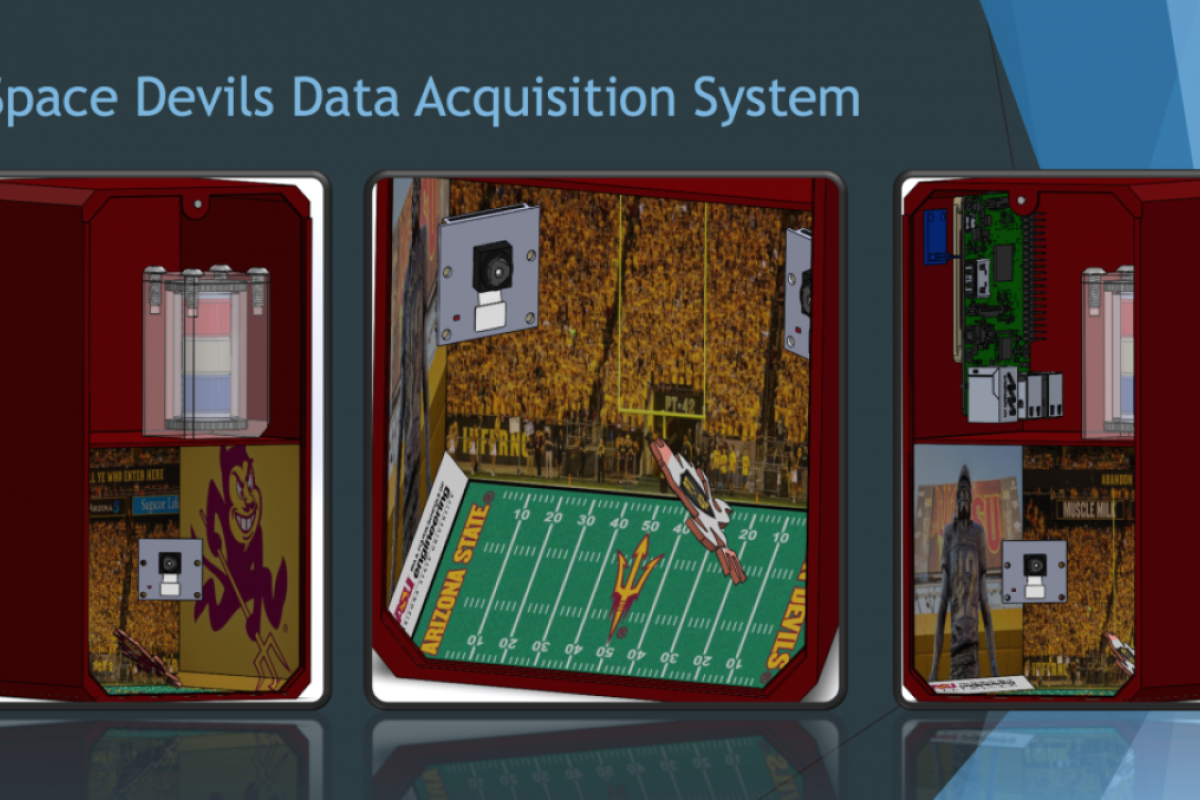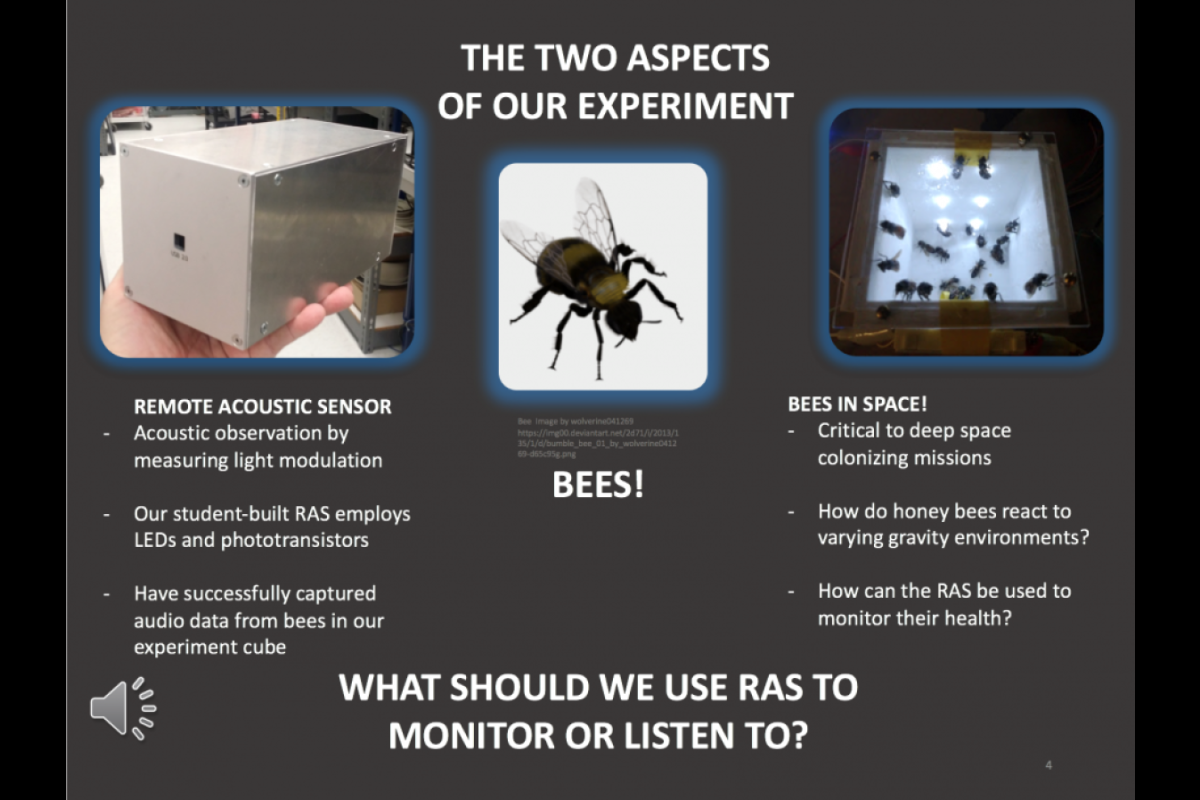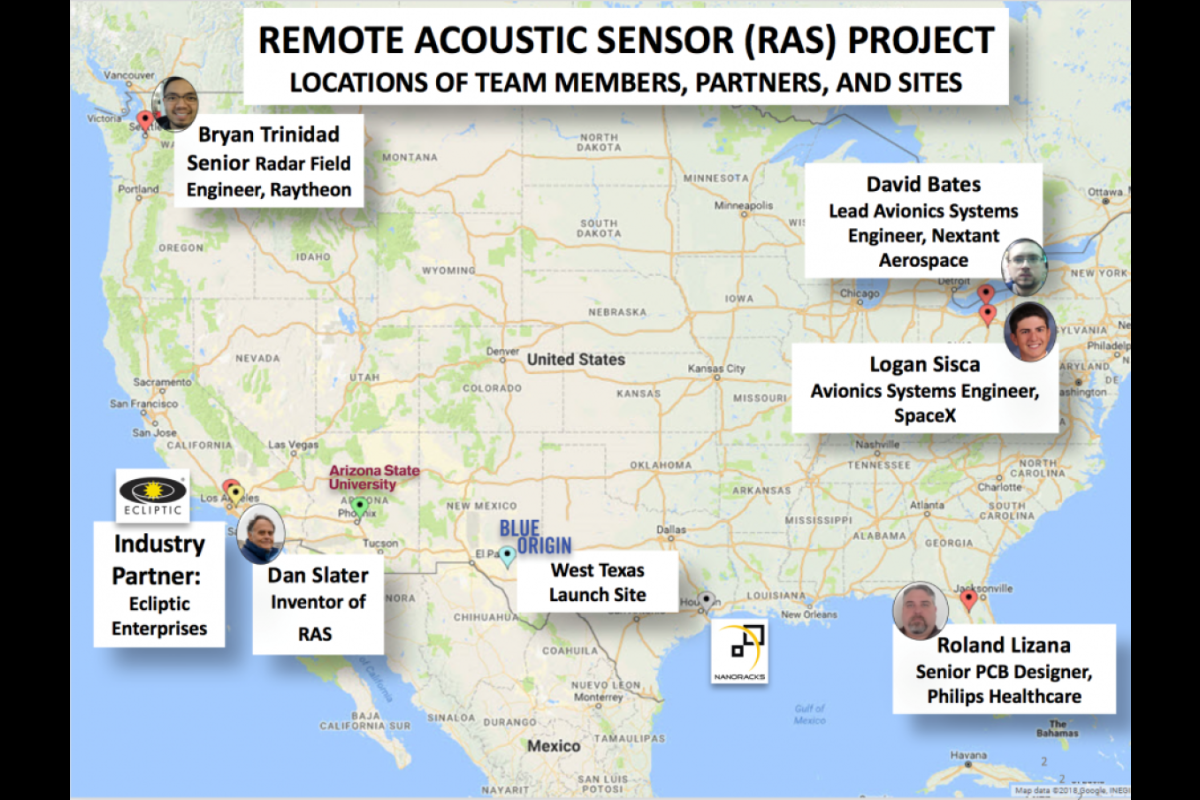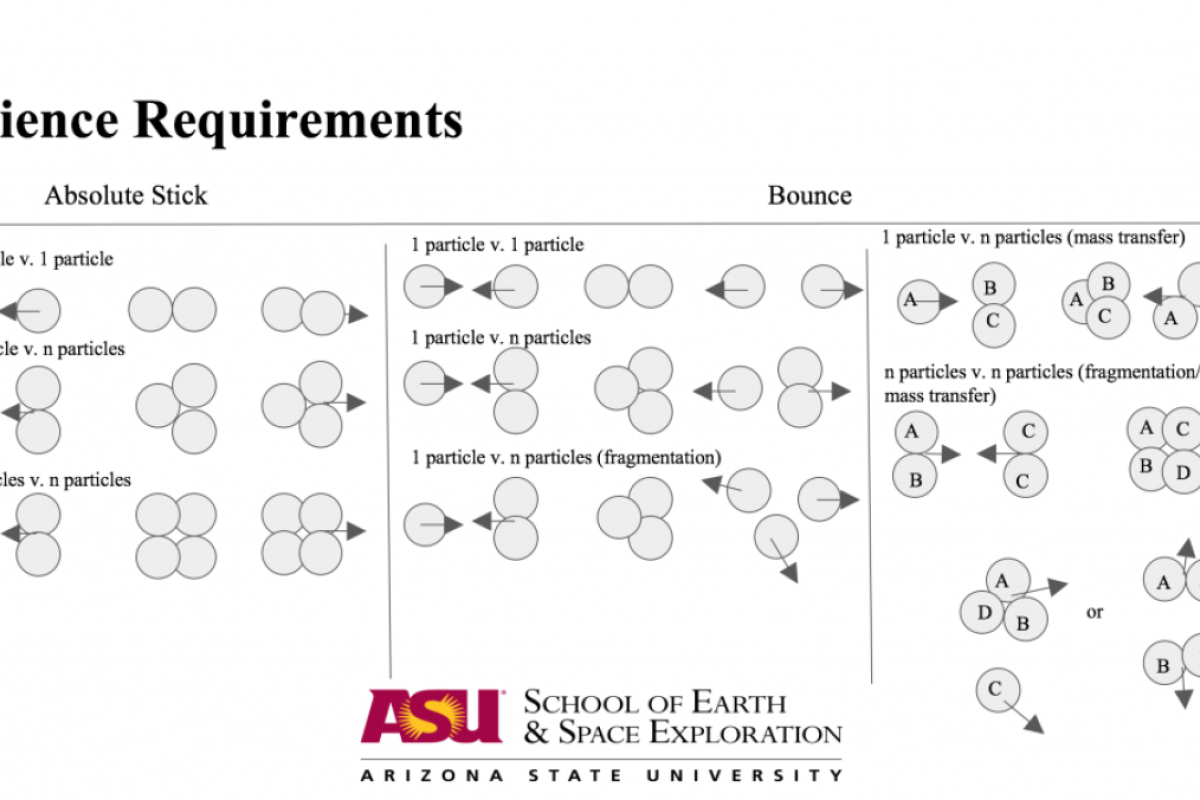ASU student payloads selected to fly on Blue Origin space vehicle
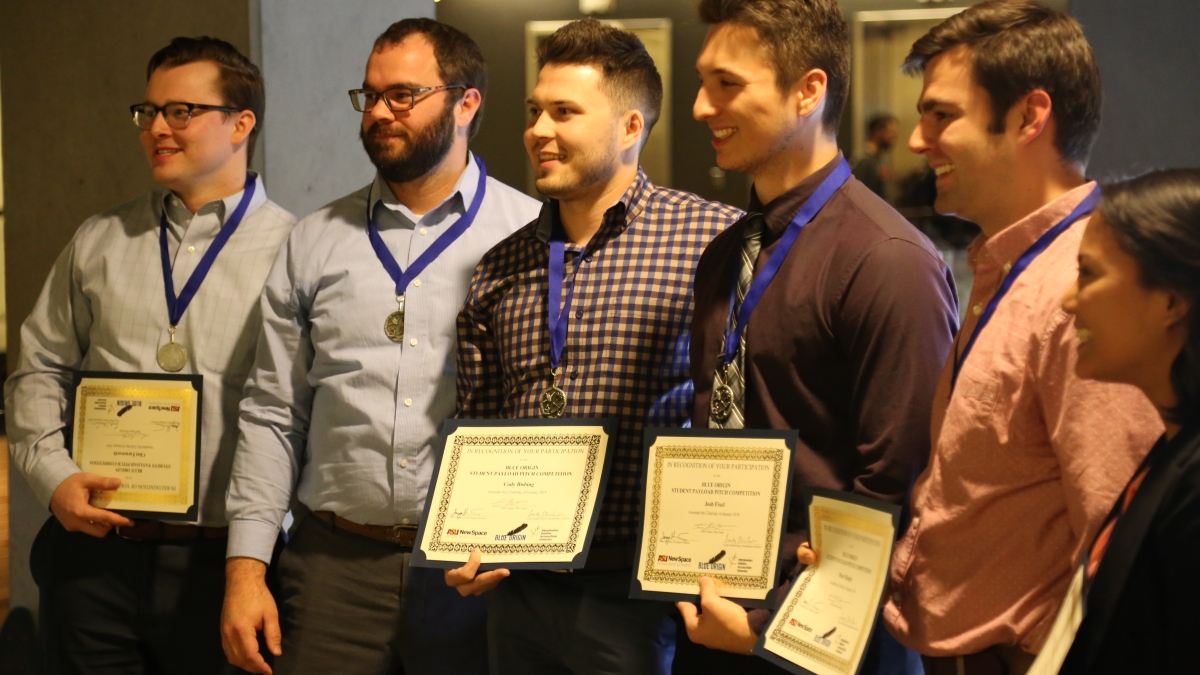
Members of the ASU Space Devils payload team include Ira A. Fulton Schools of Engineering (mechanical engineering) undergrads from L to R: Clint Farnsworth, Landon Wiltbank, Cody Bisbing, Josh Fixel, Pete Marple, and Gabby Bovaird.
Three Arizona State University student-led payload projects have been selected to launch into space on Blue Origin’s "New Shepard" space vehicle later this year.
The projects were selected during a competitive pitching competition Monday night at the School of Earth and Space Exploration. To earn a spot on "New Shepard," students were challenged to do one of three things for their payload project: answer a science question, test technology development, or engage the five senses (smell, taste, sight, touch, sound) in space.
The pitching competition was organized by ASU’s Interplanetary Initiative, a pan-university effort to build the future of humans in space, and ASU’s NewSpace, which is leading the integration of academic and commercial space enterprises using ASU’s strengths in space science, engineering, and education. A major partner in the event and the project is Blue Origin, the rocket company owned by Amazon founder Jeff Bezos.
One team from each of the three categories was selected for a prize spot on "New Shepard." The winning teams, comprised of students from both the Ira A. Fulton Schools of Engineering and the School of Earth and Space Exploration, will be designing and building the payloads at ASU.
The three teams selected for launch are, by category: Particle Interactions in Microgravity (science category), Remote Acoustic Sensor (technology category), and Space Devils (five senses in space category).
“This competition provides ASU students the unique opportunity to design their own payloads from the ground up and actually fly them into space on a state-of-the-art reusable rocket,” said Interplanetary Initiative’s Tanya Harrison, who is a post-doctoral scholar at the School of Earth and Space Exploration.
“We wanted to see what they came up with on their own from there, and we were thrilled to see the results of their ingenuity and imagination,” said Harrison, who is also the project lead for the Blue Origin/ASU payload project and the director of research for NewSpace.
The competition's judges, which included space industry representatives, academic professionals and local venture capitalists, were Erika Wagner from Blue Origin, Robert Anchondo from Honeywell Aerospace, Fred von Graf from Web3Mavens, Shawn Linham from Qwaltec and Dean Bacalzo, ASU assistant professor of industrial design.
The payloads are expected to launch in late 2018 from the Blue Origin Facility in west Texas, approximately two hours east of El Paso. The "New Shepard" vertical takeoff and landing vehicle is capable of carrying hundreds of pounds of payload per flight and is ultimately expected to carry six astronauts to altitudes beyond 100 kilometers, the internationally recognized boundary of space.
“This competition shows that the opportunity exists for ASU students to design, build and fly in space,” said Pete Swan, Interplanetary Initiative team member and space industry expert. “In the past it’s been rare, but now it can be a part of the experience of being a student at ASU.”
The winning payloads and teams
Five senses category project winner: Space Devils
The Space Devils “Five Senses” payload will focus on measuring and collecting data on sight, smell, taste, touch and sound in space. It has, as its centerpiece, an ASU Sparky figure attached to a spring. During ascent and decent, Sparky will be pushed up and down, creating the illusion that Sparky is doing push-ups, which will be measured by an accelerometer. A camera will record the push-ups, a microphone will capture the sounds of the spaceflight, and air will be pulled into the payload and passed through scent paper to capture the smell of space.
Members of the team include Ira A. Fulton Schools of Engineering (mechanical engineering) undergrads: Cody Bisbing, Gabby Bovaird, Clint Farnsworth, Josh Fixel, Peter Marple and Landon Wiltbank. The lead faculty mentor for this team is Abdelraham Shuaib of the Ira A. Fulton Schools of Engineering.
Technology category project winner: Remote Acoustic Sensor
For humans to live in space, agricultural development will be necessary, and bees, as master pollinators, will likely be an essential part of successful crops. But how do bees react in space? This project will use the emerging technology of remote acoustic sensing to capture acoustic data from the bees, as well as to record the vibrations, pressures, and orientation in space.
Members of the team include Ira A. Fulton Schools of Engineering (electrical engineering) undergrads Bryan Trinidad, David Bates, Roland Lizana and Logan Sisca. The lead faculty mentors for this team are Michael Goryll of the Ira A. Fulton Schools of Engineering and Danny Jacobs with the School of Earth and Space Exploration. This student team consists entirely of online students spread across the country, as well as one student, Trinidad, who is working aboard a naval vessel in the Persian Gulf. While team communication can be done online, the team also ships the payload around the world to work on it.
Science category project winner: Particle Interactions in Microgravity
This project seeks to test the agglomeration of small particles, ranging from millimeter to centimeter in size, as they make collisions in microgravity, helping us to understand how planets form.
Members of the team include School of Earth and Space Exploration undergraduates Pat Jackson (exploration systems design), Jason Pickering (astrophysics), Chris Huglin (exploration systems design), Jin Kim (astrophysics), Kevin White (astrobiology), Kanishka Nirmale (astrophysics) and Mitchell Drake (explorations systems design). The lead faculty mentor for this team is Chris Groppi, with the School of Earth and Space Exploration.
More Science and technology

Indigenous geneticists build unprecedented research community at ASU
When Krystal Tsosie (Diné) was an undergraduate at Arizona State University, there were no Indigenous faculty she could look to…

Pioneering professor of cultural evolution pens essays for leading academic journals
When Robert Boyd wrote his 1985 book “Culture and the Evolutionary Process,” cultural evolution was not considered a true…

Lucy's lasting legacy: Donald Johanson reflects on the discovery of a lifetime
Fifty years ago, in the dusty hills of Hadar, Ethiopia, a young paleoanthropologist, Donald Johanson, discovered what would…
